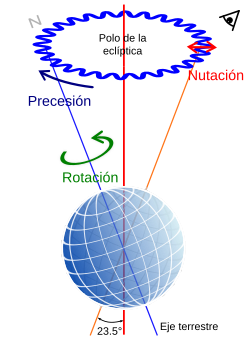Nutation
The nutation (from the Latin nutare, 'to nod' or 'oscillate') is an irregular slight movement in the axis of rotation of symmetrical objects that rotate on their axis. Common examples are gyroscopes, spinning tops, and planets. More exactly, a pure nutation is the movement of the axis of rotation that keeps the first Euler angle (precession) constant.
The movement of the Earth's nutation was discovered in 1728 by the English astronomer James Bradley, and made known in the year 1748. Until twenty years later the cause of this extra movement of the Earth's axis was not known. it was the gravitational pull exerted by the Moon.
Nutation of the Earth's axis
In the case of the Earth, nutation is the periodic oscillation of the Earth's axis of rotation around its average position on the celestial sphere, due to the external forces of gravitational attraction between the Moon and the Sun with the Earth. This oscillation is similar to the movement of a spinning top (spinning top).
In the case of the Earth, the nutation is superimposed on the movement of precession and the rolling of the obliquity of the ecliptic in such a way that they are not regular, but rather wavy, the theoretical cones that the projection in the space of the Earth would draw. displacement of the Earth's axis due to precession. Nutation causes the Earth's axis of rotation to oscillate every 18.6 years by up to about nine seconds of arc on each side of the mean value of the obliquity of the ecliptic and up to about seventeen seconds on each side of the mean value of the displacement of the Aries point on the ecliptic due to the precession of the equinoxes.
The Sun produces another nutation effect of much less relevance, with an average period of half a year increasing the oscillation of the aforementioned axis up to 1.1" of arc in obliquity and up to about 2" of arc in length (precession).
The other planets also produce variations, called perturbations, but they are not important due to their small value.
Currently the average obliquity is just under 23°26'16", this angle and its complement (66°33'44") corresponding to the average latitude of the tropics and the polar circles respectively. Mean obliquity is decreasing 0.47" per year, which is reflected in an annual displacement of 14.4 m from the tropics and polar middle circles. However, nutation continually modifies the obliquity by up to just over 3" from one year to another in years of maximum difference, the same as when they are of the same sign as the variation in obliquity adds up to 3.5", which on earth represent up to 110 m of difference from one year to another between the location of the tropics and true polar circles.
In each 18.6-year cycle the difference in location between the tropics and the mean and true polar circles can reach up to about 300 m, and the location of the tropics and the true polar circles can exceed 700 m in ten years, maximum period of removal before starting the next cycle.
Since the nutation motion depends on the internal structure of the Earth, the discrepancies between the predicted and observed values provide modeling information for the Earth's core.
The phenomena of movement of the pole and inconstancy of the terrestrial rotation appear as a consequence of small changes in the angular momentum of the Earth. This change is due to many different phenomena, among which we can mention the exchange of angular momentum between the Earth and its atmosphere, and between the Earth and the Moon, change in the height of the sea level and ocean currents, produced by the tidal phenomenon, mechanical couplings between the movements of the core and mantle fluids, among others.
Contenido relacionado
Pluto (dwarf planet)
Vector (disambiguation)
Electricity
